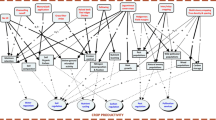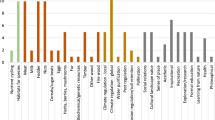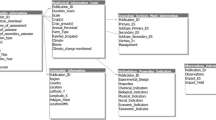Abstract
The interest in improved environmental sustainability of agriculture via biodiversity provides an opportunity for placed-based research on the conceptualization and articulation of ecosystem services. Yet, few studies have explored how farmers conceptualize the relationship between their farm and nature and by extension ecosystem services. Examining how farmers in the Southern Piedmont of South Carolina discuss and explain the role of nature on their farm, we create a detail-rich picture of how they perceive ecosystem services and their contributions to the agroeconomy. Using 34 semi-structured interviews, we developed a detail-rich qualitative portrait of these farmers’ conceptualizations of ecosystem services. Farmers’ conceptualization of four ecosystem services: provisioning, supporting, regulating, and cultural are discussed, as well as articulation of disservices. Results of interviews show that most interviewees expressed a basic understanding of the relationship between nature and agriculture and many articulated benefits provided by nature to their farm. Farmers referred indirectly to most services, though they did not attribute services to biodiversity or ecological function. While farmers have a general understanding and appreciation of nature, they lack knowledge on specific ways biodiversity benefits their farm. This lack of knowledge may ultimately limit farmer decision-making and land management to utilize ecosystem services for environmental and economic benefits. These results suggest that additional communication with farmers about ecosystem services is needed as our understanding of these benefits increases. This change may require collaboration between conservation biology professionals and extension and agriculture professionals to extended successful biomass provisioning services to other ecosystem services.


Similar content being viewed by others
References
Arbuckle JG, Wright Morton L, Hobbs J (2013) Farmer beliefs and concerns about climate change and attitudes toward adaptation and mitigation: evidence from Iowa. Clim Change 118(3-4):551–563
Barnes AP, Toma L (2012) A typology of dairy farmer perceptions towards climate change. Clim Change 112:507–522
Batie SS (2009) Green payments and the US Farm Bill: information and policy challenges. Front Ecol Environ 7:380–388
Bennett EM, Peterson GD, Gordon LJ (2009) Understanding relationships among multiple ecosystem services. Ecol Lett 12:1394–1404
Biernacki P, Waldorf D (1981) Snowball sampling: problems and techniques of chain referral sampling. Sociol Methods Res 10:141–163
Boody G, Vonderacek B, Andow DA, Krinke M, Westra J, Zimmerman J, Welle P (2005) Multifunctional agriculture in the United States. Bioscience 55:27–38
Collins A, Gentner D (1987) How people construct mental models. In: Holland D, Quinn N (eds) Cultural models in language and thought. Cambridge University Press, Cambridge, pp 243–268
Costanza R, d’Arge R, De Groot R, Farber S, Grasso M, Hannon B, Limburg K, Naeem S, O’Neill RV, Paruelo J (1998) The value of the world’s ecosystem services and natural capital. Ecol Econ 25:3–15
Creswell JW (1998) Qualitative inquiry and research design: choosing among five traditions. Sage Publications, Thousand Oaks
Creswell JW (2013) Qualitative inquiry and research design. Sage Publications, Thousand Oaks
Daily G (1997) Nature’s services: societal dependence on natural ecosystems. Island Press, Washington
Daily GC, Matson PA (2008) Ecosystem services: from theory to implementation. Proc Natl Acad Sci USA 105:9455–9456
Drummond MA, Loveland TR (2010) Land-use pressure and a transition to forest-cover loss in the eastern United States. Bioscience 60:286–298
Eckard J, Gonzalez-Hernandez JL, Caffe M, Berzonsky W, Bockus WW, Marais GF, Baenziger PS (2015) Native Fusarium head blight resistance from winter wheat cultivars ‘Lyman’,‘Overland’,‘Ernie’,and ‘Freedom’mapped and pyramided onto ‘Wesley’-Fhb1 backgrounds. Mol Breed 35(1):1–16
Ellis EC, Klein Goldewijk K, Siebert S, Lightman D, Ramankutty N (2010) Anthropogenic transformation of the biomes, 1700 to 2000. Global Ecol Biogeogr 19:589–606
Francis CA, King JW (1988) Cropping systems based on farm-derived, renewable resources. Agr Syst 27(1):67–75
Glaser B, Strauss A (1967) The discovery of grounded theory: strategies for qualitative research. Aldine Publishing Company, New York
Green J, Thorogood N (2009) Qualitative methods for health research, 2nd edn. Sage, Thousand Oaks
Halfacre A (2012) A delicate balance: constructing a conservation culture in the South Carolina lowcountry. University of South Carolina Press, South Carolina
Herzon I, Mikk M (2007) Farmers’ perceptions of biodiversity and their willingness to enhance it through agri-environment schemes: a comparative study from Estonia and Finland. J Nat Con 15:10–25
Huang R (2012) RQDA: R-based qualitative data analysis. R package version 0.2-3. http://rqda.r-forge.r-project.org/
Jones AN, Ross H, Lynam T, Perez P, Leitch A (2011) Mental models: an interdisciplinary synthesis of theory and methods. Ecol Soc 16(1) 46. http://www.ecologyandsociety.org/vol16/iss1/art46
Kremen C, Williams NM, Aizen MA, Gemmill-Herren B, LeBuhn G, Minckley R, Ricketts TH (2007) Pollination and other ecosystem services produced by mobile organisms: a conceptual framework for the effects of land-use change. Ecol Lett 10(4):299–314
Lamarque P, Tappeiner U, Turner C, Steinbacher M, Bardgett RD, Szukics U, Schermer M, Lavorel S (2011) Stakeholder perceptions of grassland ecosystem services in relation to knowledge on soil fertility and biodiversity. Reg Envir Change 11:791–804
Lewan L, Söderqvist T (2002) Knowledge and recognition of ecosystem services among the general public in a drainage basin in Scania, Southern Sweden. Ecol Econ 42:459–467
Liu J, Dietz T, Carpenter SR, Alberti M, Folke C, Moran E et al (2007) Complexity of coupled human and natural systems. Science 317(5844):1513–1516
Lofland J, Snow DA, Anderson L, Lofland LH (2005) Analyzing social settings: a guide to qualitative observation and analysis. Cengage Learning, Belmont
MA (Millennium Ecosystem Assessment) (2005) Ecosystems and human well-being: a framework for assessment. General synthesis. Island Press, Washington
Matson PA, Parton WJ, Power AG, Swift MJ (1997) Agricultural intensification and ecosystem properties. Science 277:504–509
McShane TO, Hirsch PD, Trung TC, Songorwa AN, Kinzig A, Monteferri B, Mutekanga D, Thang HV, Dammert JL, Pulgar-Vidal M (2011) Hard choices: making trade-offs between biodiversity conservation and human well-being. Biol Conserv 144:966–972
Mertz O, Mbow C, Reenberg A, Diouf A (2009) Farmers’ perceptions of climate change and agricultural adaptation strategies in rural Sahel. Environ Manage 43:804–816
Miles MB, Huberman AM (1994) Qualitative data analysis—an expanded sourcebook, 2nd edn. Sage, London
Moustakas C (1994) Phenomenological research. SAGE Publications, Thousand Oaks
Olenick KL, Kreuter UP, Conner JR (2005) Texas landowner perceptions regarding ecosystem services and cost-sharing land management programs. Ecol Econ 53(2):247–260
Patton MQ (2002) Qualitative research and evaluation methods. SAGE Publications, Thousand Oaks
Perrings C, Jackson L, Bawa K, Brussaard L, Brush S, Gavin T, Papa R, Pascual U, De Ruiter P (2006) Biodiversity in agricultural landscapes: saving natural capital without losing interest. Conserv Biol 20:263–264
Power AG (2010) Ecosystem services and agriculture: tradeoffs and synergies. Philos Trans R Soc B 365:2959–2971
Pretty J, Sutherland WJ, Ashby J, Auburn J, Baulcombe D, Bell M, Bentley J, Bickersteth S, Brown K, Burke J (2010) The top 100 questions of importance to the future of global agriculture. Int J Agri Sustain 8:219–236
Prokopy LS (2011) Agricultural human dimensions research: the role of qualitative research methods. J Soil Water Conserv 66:9A–12A
Quinn JE (2013) Sharing a vision for biodiversity conservation and agriculture. Renew Agr Food Syst 28:93–96
Quinn JE, Brandle JR, Johnson RJ (2013) A farm-scale biodiversity and ecosystem services assessment tool: the healthy farm index. Int J Agric Sustain 11:176–192
Quinn JE, Brandle J, Johnson R (2014) Identifying opportunities for conservation embedded in cropland anthromes. Landsc Ecol 29(10):1811–1819
R Core Team (2013) R: a language and environment for statistical computing. R Foundation for Statistical Computing, Vienna, Austria. http://www.R-project.org/
Ricketts TH, Daily GC, Ehrlich PR, Michener CD (2004) Economic value of tropical forest to coffee production. Proc Natl Acad Sci USA 101(34):12579–12582
Sandhu HS, Wratten SD, Cullen R (2007) From poachers to gamekeepers: perceptions of farmers towards ecosystem services on arable farmland. Int J Agric Sustain 5(1):39–50
Sandhu HS, Crossman ND, Smith FP (2012) Ecosystem services and Australian agricultural enterprises. Ecol Econ 74:19–26
Schoeneberger M, Bentrup G, de Gooijer H, Soolanayakanahally R, Sauer T, Brandle J, Current D (2012) Branching out: agroforestry as a climate change mitigation and adaptation tool for agriculture. J Soil Water Conserv 67(5):128A–136A
Silvano RA, Udvardy S, Ceroni M, Farley J (2005) An ecological integrity assessment of a Brazilian Atlantic Forest watershed based on surveys of stream health and local farmers’ perceptions: implications for management. Ecol Econ 53:369–385
Smith HF, Sullivan CA (2014) Ecosystem services within agricultural landscapes—Farmers’ perceptions. Ecol Econ 98:72–80
Swinton SM, Lupi F, Robertson GP, Hamilton SK (2007) Ecosystem Services and Agriculture: cultivating agricultural ecosystems for diverse benefits. Ecol Econ 64:245–252
TNC (The Nature Conservancy) (2010) Key findings from recent national opinion research on ecosystem services. http://www.conservationgateway.org/Files/Pages/key-findings-recent-natio.aspx. Accessed April 1, 2014
Zagarola JA, Anderson CB, Veteto JR (2014) Perceiving Patagonia: an assessment of social values and perspectives regarding watershed ecosystem services and management in southern South America. Environ Manage 53(4):769–782
Zhang W, Ricketts TH, Kremen C, Carney K, Swinton SM (2007) Ecosystem services and dis-services to agriculture. Ecol Econ 64:253–256
Acknowledgments
The authors would like to thank Furman’s David E. Shi Center for Sustainability Carolinas Food and Farming Student-Faculty Research Initiative funded by The Duke Endowment.
Author information
Authors and Affiliations
Corresponding author
Appendix: Interview Protocol
Appendix: Interview Protocol
Farm/Farmer History
To start, I would like to know a little bit about your personal history with farming as well as the history of your farm…
-
a.
When did you first start farming?
-
b.
Did you grow up around farming?
-
c.
Did your parents farm?
-
d.
Grandparents? (older generations?)
-
e.
Did they farm on this land or somewhere else?
-
f.
When did you begin farming here?
-
g.
How did you learn to farm?
-
h.
Is your farm in one contiguous parcel or separated?
-
i.
Do you know who owned the land previously and what did they use it for?
What would you consider a large farm/small farm?
-
a.
So then do you consider yourself a (large/small) scale farmer?
-
b.
What are the benefits to your size farm?
-
c.
What are the challenges of your size farm?
Farmers in the Upstate
I would like to ask you more general questions about farming and farmers in the Upstate.
-
What type of person farms in the Upstate?
-
Why do you think they farm?
-
What makes a good farmer? (wait for response and prompt with below if necessary)
-
Farming practices? (farm organization, use of technologies etc.)
-
Social practices? (i.e., being involved with community, farming organizations etc.)
Changes
Farming has changed so much in the past century. I’d like to hear your opinion on these changes.
-
Have your feelings about farming changed over your life?
-
What are the greatest challenges you have faced in the past? Now?
-
What do you most enjoy? Is this the same as in the past?
-
Is farming changing in the Upstate?
-
Are the people who farm changing? (age, gender, race, type of farming practices)
-
Do you see urban/suburban development as a threat to the farming community in this region?
How does farming influence culture in this region?
-
What role does farming play in the Upstate?
-
Do you think that most people are aware of farming and agricultural issues in the Upstate?
What do you most hope to see for the future of farming in this region?
-
What most needs to be sustained or conserved with respect to farming?
Land/Nature Conservation — I would like to ask you some questions about the importance of land, farmers’ connection to the land, and nature
What is farmland?
-
Do you think of your farmland as part of nature?
-
Do you think of yourself as someone who works in nature?
What does your land mean to you?
-
What does it mean for your family?
-
How important is it to you that your land continues to be farmed?
-
What sort of things do you do to be a steward of the land?
-
Have you ever been approached about special protections for your land?
-
How important is it for you that this land remains farmland after you retire?
Nature Conservation
-
If someone approached you about conserving nature on your land, how much do you think you’d be willing to do?
-
How does nature benefit your farm?
-
Do you have any wildlife habitat on your farm? (areas you do not use for production)
-
Do you have any specific practices to control water or soil run-off?
-
Do other farmers care about the environment?
-
Do other farmers in the area do anything on their farm specifically to benefit nature?
-
Would you be interested in eco-tourism at your farm (birding tours?)
What sort of outdoor recreational activities do you enjoy?
-
Do you hunt or fish?
-
Do you do those activities on your farm? If not, where else?
-
Do you identify/notice/take an interest in wildlife on your farm? birds, mammals, insects
Marketing
Selling products is just as important to farming as growing products. I would like to ask just a few questions about where you sell your products.
-
Do you sell directly to consumers? How?
-
CSA
-
Roadside stand
-
Pick your own
-
Farmers markets
-
-
Do you sell to grocery stores?
-
What sorts of consumers purchase from you?
-
Has the type of consumer changed over time?
-
Does your farm have a website?
-
Do you participate in South Carolina Grown program?
-
Are you certified for any special labeling?
-
Organic?
-
Biodynamic?
-
How competitive is the market for farm products in this area?
-
Who are you competing with?
-
Do farmers in this area work together to grow or market products? Why or why not?
How familiar are you with the local/organic food movements?
-
What do you think about the local/organic food movement?
What advice would you have for upcoming farmers?
-
What sorts of challenges might upcoming farmers face?
-
Do your children want to farm?
Agricultural Practices
-
What sorts of agricultural techniques do you use?
-
Have you always farmed this way? What practices have you changed over the years? Why?
-
Do you use any specific techniques to preserve fertility of the land?
-
Have you ever tried other methods of farming? Were they successful?
-
Do you rotate crops? IPM? Terracing?
Do you draw income from non-farm sources?
-
Has this amount of income increased or decreased in recent years?
-
Do you think you will need to draw more or less income from non-farm sources in the future?
Rights and permissions
About this article
Cite this article
Quinn, C.E., Quinn, J.E. & Halfacre, A.C. Digging Deeper: A Case Study of Farmer Conceptualization of Ecosystem Services in the American South. Environmental Management 56, 802–813 (2015). https://doi.org/10.1007/s00267-015-0534-9
Received:
Accepted:
Published:
Issue Date:
DOI: https://doi.org/10.1007/s00267-015-0534-9




